《1 Introduction》
1 Introduction
Since the beginning of the 21st century, China has undergone drastic changes in population structure, lifestyle, disease spectrum, health needs, and major health problems [1,2], and witnessed profound revolution in disease prevention models, diagnosis and treatment approaches, and management tools and skills [3–5]. For the next 20 years up to 2035, China’s economic and social development has entered a new era of macroscopic transitions. One key component of such transitions is the development of innovative engineering science and technology to meet the urgent needs for improvement and enhancement of medicine and population health.
The present technology foresight program was sponsored by the Medicine and Healthcare Department of the Chinese Academy of Engineering; it was conducted in compliance with the framework and guidelines provided in the Research on China’s Engineering Science and Technology Development Strategy 2035. The Delphi methods were adopted in this study, based on the views and opinions of selected academicians/specialists in the field of medicine and population health. The Delphi questionnaire was prepared based upon the worldwide most-updated technology foresight, literature metrology, and patent review. The aim of this study was to identify the best potential technologies among the 75 emerging technologies in 12 subfields in medicine and population health at producing the greatest economic and social benefits to China in 2035.
《2 Outline of the Delphi survey》
2 Outline of the Delphi survey
Twelve subfields and 75 technologies pertinent to medicine and population health were listed in the present Delphi questionnaire employed in this study. A total of 1 760 experts were invited to this survey; 484 of them completed the questionnaire, for a participation rate of 27.05 %, and 479 disclosed their organization identity (Fig. 1).
《Fig. 1》
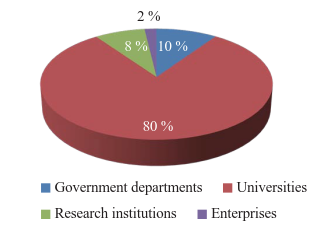
Fig. 1. Distribution of the participating experts’ affiliated organizations.
Overall, 62 % of the participating experts checked the options “very familiar” and “familiar” regarding the listed technologies in the completed questionnaires (Fig. 2). Such result indicated that the answers were professional overall, and the statistical analysis of the survey data had a high reference value.
《Fig. 2》

Fig. 2. Distribution of the experts’ familiarity with the technologies listed in the questionnaire.
《3 Key technology directions in medicine and population health》
3 Key technology directions in medicine and population health
The top 10 key technologies are listed in Table 1. Detailed descriptions of the top three technologies are provided below.
《Table 1》
Table 1. Important directions of key technologies in medicine and population health.
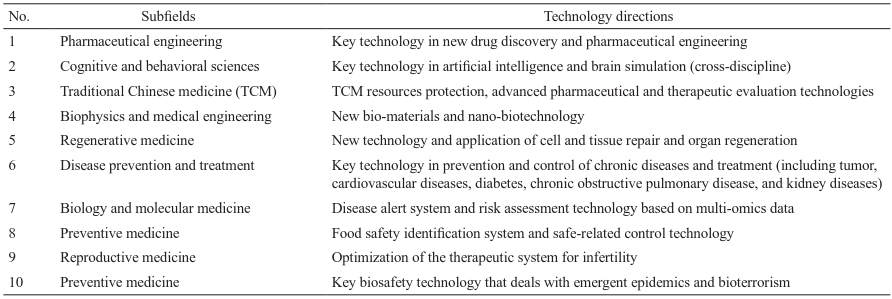
《3.1 Future development trends of key technologies in new drug discovery and pharmaceutical engineering》
3.1 Future development trends of key technologies in new drug discovery and pharmaceutical engineering
For the time being, the ability for research and development (R&D) of new drugs in the pharmaceutical industries and research institutions in China is still not considered as advanced compared with that of the United States (US) and other developed countries. A successful new drug discovery requires wellmatched technologies for identifying and/or synthesizing compounds/molecules with high efficacy, safety, and low toxicity and drug resistance. Technologies that permit the integration of genetic and epigenetic determinants of disease are anticipated to promote and accelerate robustly the development of pharmaceutical engineering in China.
《3.2 Key technology in artificial intelligence and brain simulation (cross-discipline)》
3.2 Key technology in artificial intelligence and brain simulation (cross-discipline)
The purpose of developing artificial intelligence is to create an artificial thinking system that is compatible with or even superior to the thinking ability of biological humans. Currently, technologies that have garnered the common interest mainly include, among others, hearing and vision communication assistive devices, cognitive computing and nervous system boosting equipment, brain cognition-based visual processing modules,vision-based natural environment perceptive and sensing technology, multi-level neural information detection technology, automatic language recognition technology, artificial retina produced by computer vision principle, and artificial brain guidance system technology. Artificial intelligence and brain simulation will become important symbols of technological advances in the future. To this end, Western countries, which are represented by the US, have launched several projects on artificial intelligence and brain simulation. These ongoing projects have entered onto the express road of development. During the period of the 13th Five-Year Plan, from 2016 to 2020, great efforts will also be exerted in China to boost the R&D of artificial intelligence and brain simulation technologies. However, this goal can be achieved only by facilitating and strengthening the interdisciplinary cooperation on a long-term basis, to work out an effective and efficient mechanism for battling the difficult problems of nervous system diseases, which remain incurable with China’s currently available conventional clinical treatments and rehabilitation procedures.
《3.3 TCM resources protection, advanced pharmaceutical and therapeutic evaluation technologies》
3.3 TCM resources protection, advanced pharmaceutical and therapeutic evaluation technologies
China is indisputably the world leader in traditional Chinese medicine (TCM). Nevertheless, rational exploitation, utilization, and protection of TCM resources are the top issues for the sustainable utilization of resources. Such issues must be highly valued by the medical and pharmaceutical industries, and regulations must be implemented by the legislative authority. To facilitate the development of pharmaceutical industry of Chinese medicine, technologies for identification and extraction of natural active ingredients and therapeutic evaluation of the efficacy and safety of TCM must be established.
《4 Future development trends of generic technologies in medicine and population health》
4 Future development trends of generic technologies in medicine and population health
Table 2 summarizes the top 10 generic technologies selected by the expert participants of this study. Notably, the first item, pharmaceutical engineering, is identical to the first direction for the key technologies. Thus, the subsequent discussion focuses on the second and third technologies.
《Table 2》
Table 2. Important directions of generic technology in medicine and population health.
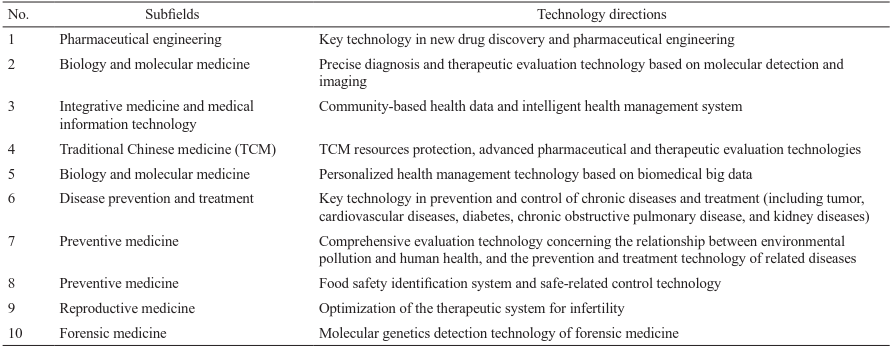
《4.1 Precision diagnosis and therapeutic evaluation technology based on molecular detection and imaging》
4.1 Precision diagnosis and therapeutic evaluation technology based on molecular detection and imaging
With the development and improvement of molecular detection and molecular imaging technologies, a tremendous advancement has been made in precision diagnosis and therapeutic evaluation in live body (in vivo) and laboratories (in vitro). However, the presently available molecular imaging technology is still far from being powerful enough for precisely locating and examining the cells and molecules of living tissues. Therefore, the development of a high definition and precision optical molecular imaging system becomes an urgent task. Such system must be integrated into the molecular detection technologies for an early warning and diagnosis of diseases and an individualized therapeutic evaluation.
《4.2 Community-based health data and intelligent health management system》
4.2 Community-based health data and intelligent health management system
The integration of the Internet Plus, China’s counterpart to Information Superhighway and Industry 4.0, and big health industry has led to the state of high-speed development of the technologies based on computer science, communications, cloud computing, and big data. The individual-centered health data are accumulating rapidly; they will likely form a big health databank in the next five to 10 years. When combined with hospital data on diagnoses and therapy through an internet communication, such a database can, in turn, expand to a massive volume of big medical data. It is foreseen that establishing an intelligent health management and service system for high throughput analysis and processing of big data will enable major breakthroughs in the domain of intelligent medicine and health management.
《5 Future development trends of revolutionary technologies in medicine and population health》
5 Future development trends of revolutionary technologies in medicine and population health
Table 3 summarizes the top 10 revolutionary technologies, among which the second technology direction within the top three technologies corresponds to key and generic technologies. Thus, the subsequent discussion focuses on the first and third technologies.
《Table 3》
Table 3. Important directions of revolutionary technology in medicine and population health.
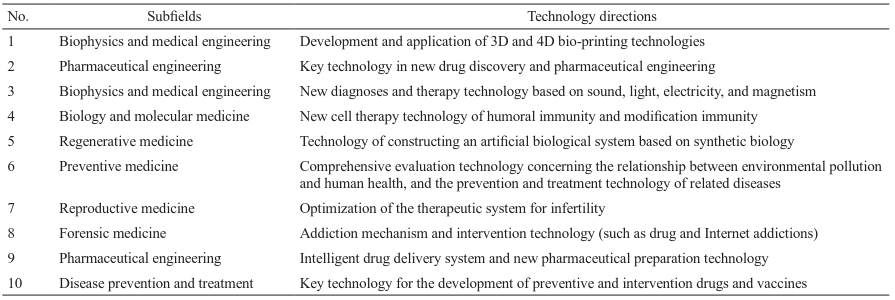
《5.1 Development and application of 3D and 4D bio-printing technologies》
5.1 Development and application of 3D and 4D bio-printing technologies
3D bio-printing is the next frontier of 3D printing technology, which has gained its momentum for rocket-speed development since recent years. With the integration of time dimension into automatic deformable materials, 4D bio-printing can open an infinite space for therapeutic applications of biomedical sciences and technologies. Breaking the critical technological barriers and developing a new technology for high-rate material synthesis is an important approach for constructing complex full-functioning tissues or organs for regenerative medicine. A continuous translational research on 3D and 4D bio-printing will boost up the realization of these technologies for clinical applications.
《5.2 New diagnoses and therapy technology based on sound, light, electricity, and magnetism》
5.2 New diagnoses and therapy technology based on sound, light, electricity, and magnetism
The future direction of this subfield will be to develop the systems that enable a non-invasive, real-time, dynamic,high-sensitivity, fast tracing, and multi-modality monitoring of lesions for precise diagnosis and effective treatment of a disease. This will require development of the technologies for a site-specific synthesis of the molecular probes through an in-situ biological effect, which allows for precision targeting, and fast labeling and imaging of lesions, such as those found in cancer, and cardiovascular and cerebrovascular diseases. One example is the near-infrared fluorescent probe for targeted imaging of lesion to facilitate disease diagnosis and treatment.
《6 Time distribution of realization of technologies in medicine and population health》
6 Time distribution of realization of technologies in medicine and population health
《6.1 Anticipated time distribution of realization》
6.1 Anticipated time distribution of realization
The timeline required for the realization of the technologies listed in this study’s Delphi questionnaire in developed nations is anticipated to range from 2019 to 2031, with majority of the developments expected to happen between 2022 and 2026 (Fig. 3, top panel). Within this timeframe, 55 of the 75 technologies (73 %) in the list can be realized.
《Fig. 3》

Fig. 3. Comparison for the three expected realization timelines. (a) Technology realization time (worldwide); (b) technology realization time (in China); (c) social realization time (in China).
By comparison, the technology realization time in China will have a lag of three to five years (Fig. 3, middle panel). In addition, the social realization time (Fig. 3, bottom panel) is anticipated to be two to three years longer than technology realization time in China.
《6.2 Analysis of timespan of technology realization between the world and China》
6.2 Analysis of timespan of technology realization between the world and China
Except for the seven technologies related to TCM, 68 of the 75 technologies in the list are envisaged to be realized in China with a lag behind the world for an average of 2.6 years (Fig. 4).
《Fig. 4》

Fig. 4. Time discrepancy of technological realization between China and the world.
The realization of the optimization of the therapeutic system for infertility, as well as of the novel medical supplies and facilities for TCM in China, is expected to be within the same timeline as that in developed nations.
Six technologies are anticipated to be realized within the period 2026–2030 in China, representing a four- to five-year lag behind the Western world. This list includes the key technologies in new drug discovery and pharmaceutical engineering, intelligent drug delivery system and new pharmaceutical preparation, research on large (super) cohort studies and the corresponding data mining and analysis, prevention and control of nervous system diseases, behavioral measurement and interventions in children and adolescents, and construction of synthetic biologybased artificial biosystems. A large gap remains between China and the Western world in terms of the development of the above six technologies.
《6.3 Analysis of timespan between technological and social realization in China》
6.3 Analysis of timespan between technological and social realization in China
The timespan from technological to social realization of the 75 listed technologies in China ranges from one to four years, with an average of 2.3 years (Fig. 5).
《Fig. 5》

Fig. 5. Time discrepancy between technological and social realization in China.
Among the various technologies, the optimization of the therapeutic system for infertility and non-invasive prenatal and pre-implantation genetic diagnoses will take the lead for technological realization in 2020 and find their clinical applications as social realization in 2021.
The time of realization for the other technologies, such as the that for stem cell-based oral and facial organ regeneration, development principle-based oral and facial organ regeneration, controllable human body building and rebuilding, and artificial intelligence and brain simulation (cross-discipline) is anticipated to fall behind to the years 2032–2033.
《7 Achievable levels and restriction factors of technology development in medicine and population health》
7 Achievable levels and restriction factors of technology development in medicine and population health
《7.1 R&D index》
7.1 R&D index
The technology directions and R&D index of all subfields in medicine and population health fields were analyzed (Table 4). The averaged R&D index for the 75 technologies is 33.29 overall. The average R&D index for the seven TCM subfields is 82.54. When excluding TCM, the average R&D index for 11 other subfields drops to 28.22. These data indicate that the overall R&D level in medicine and health sectors in China remains relatively low.
《Table 4》
Table 4. Results of R&D indexes of the subfields in medicine and population health.
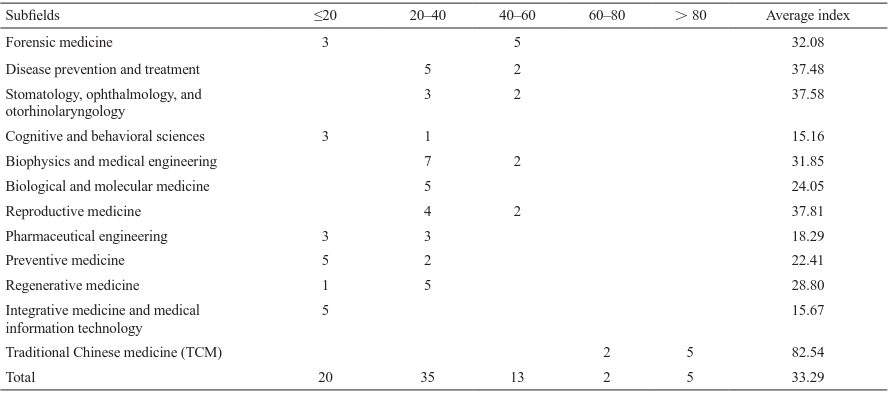
《7.2 Technology-leading countries》
7.2 Technology-leading countries
Among the countries and regions with more advanced technologies in medicine and health, the United States dominates in all subfields, except for TCM, followed by the European Union and Japan. China is the leading nation in TCM, and Japan has certain strengths in this subfield. The results are illustrated in Fig. 6.
《Fig. 6》

Fig. 6. Distribution of technology-leading countries.
《7.3 Restriction factors》
7.3 Restriction factors
Overall, insufficiency in the talent team of qualified R&D personnel and in technology resources are the main restricting factors in the development of medical technologies; the inadequate financial investment in R&D is another limiting factor. Industrial infrastructure and capability appear to exert only moderate influence on the development of medical technologies (Fig. 7). The restriction factors in each subfield are displayed in Fig. 8.
《Fig. 7》

Fig. 7. Restriction factors in the field of medicine and population health.
《Fig. 8》
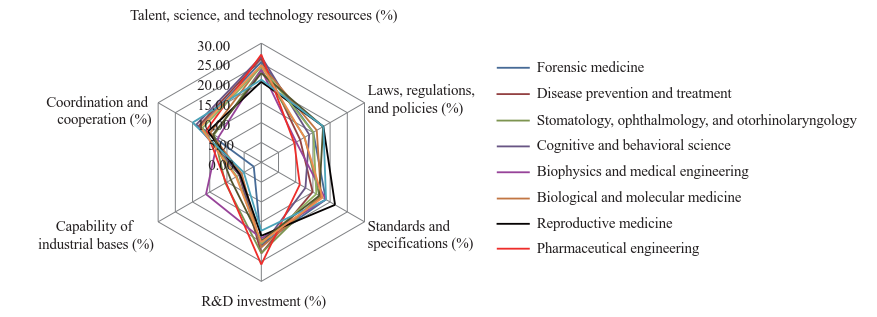
Fig. 8. Restriction factors in subfields of medicine and population health.
《8 Conclusions》
8 Conclusions
In this article, we forecast the trend of development of top 10 important key, generic, and revolutionary technologies in the field of medicine and population health of the Chinese Engineering Science and Technology within the next 20 years up to 2035, based upon the results of the Delphi survey, in conjunction with the careful and detailed analyses conducted by a panel of experts. Overall, the realization time of the medical technologies in China will likely lag by three to five years compared with that of the Western countries. The overall level of R&D for about 80.88 % of the listed technologies, excluding TCM, is still in arrears. The foremost limiting factors for the realization of the medical technologies in China are insufficient human resources of talent teams and science and technology power, in addition to an inadequate R&D investment. Hence, strengthening the constant training and reservation of a talent team is the top priority in the long run. Moreover, the investment on R&D must be increased. Additionally, the related legislations, regulations and policies, together with industrial standards in the related sectors,must be implemented and/or strengthened to safeguard and facilitate the development of key technologies in China [6–8].














 京公网安备 11010502051620号
京公网安备 11010502051620号




